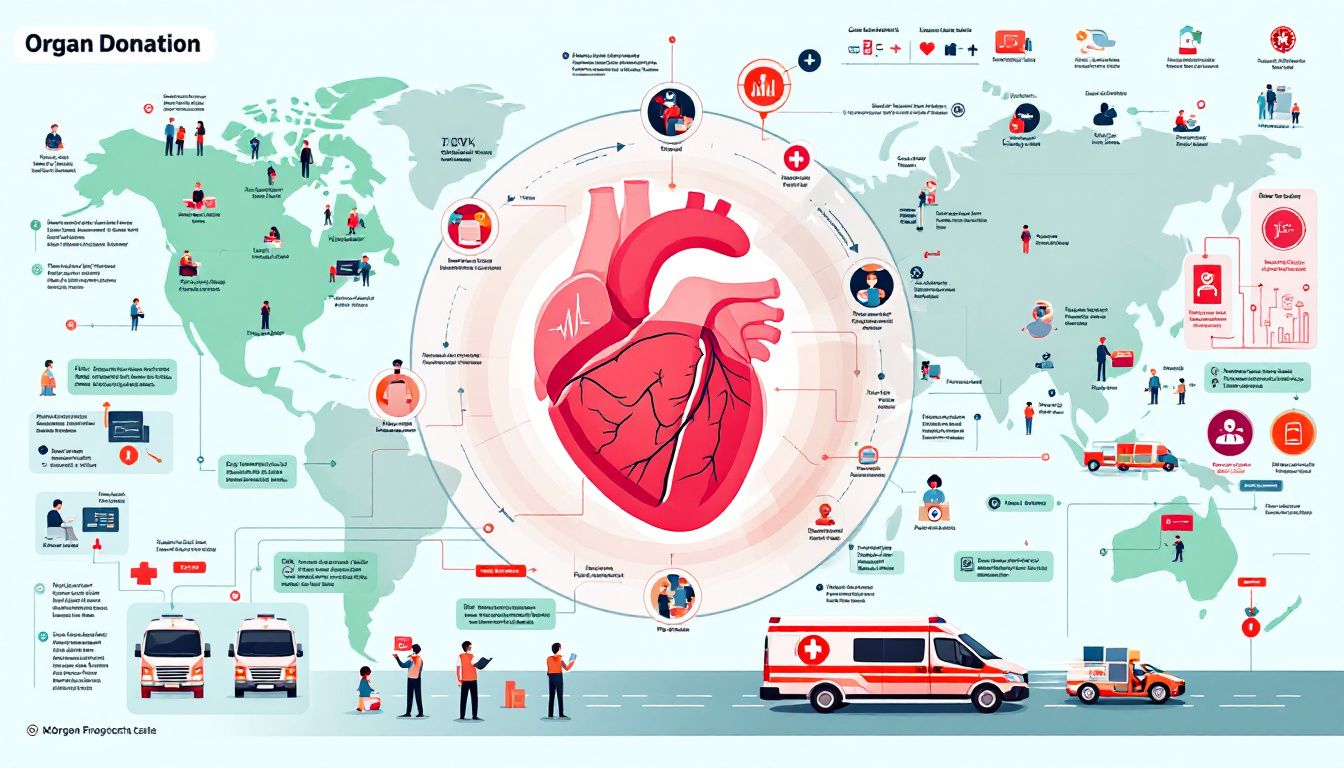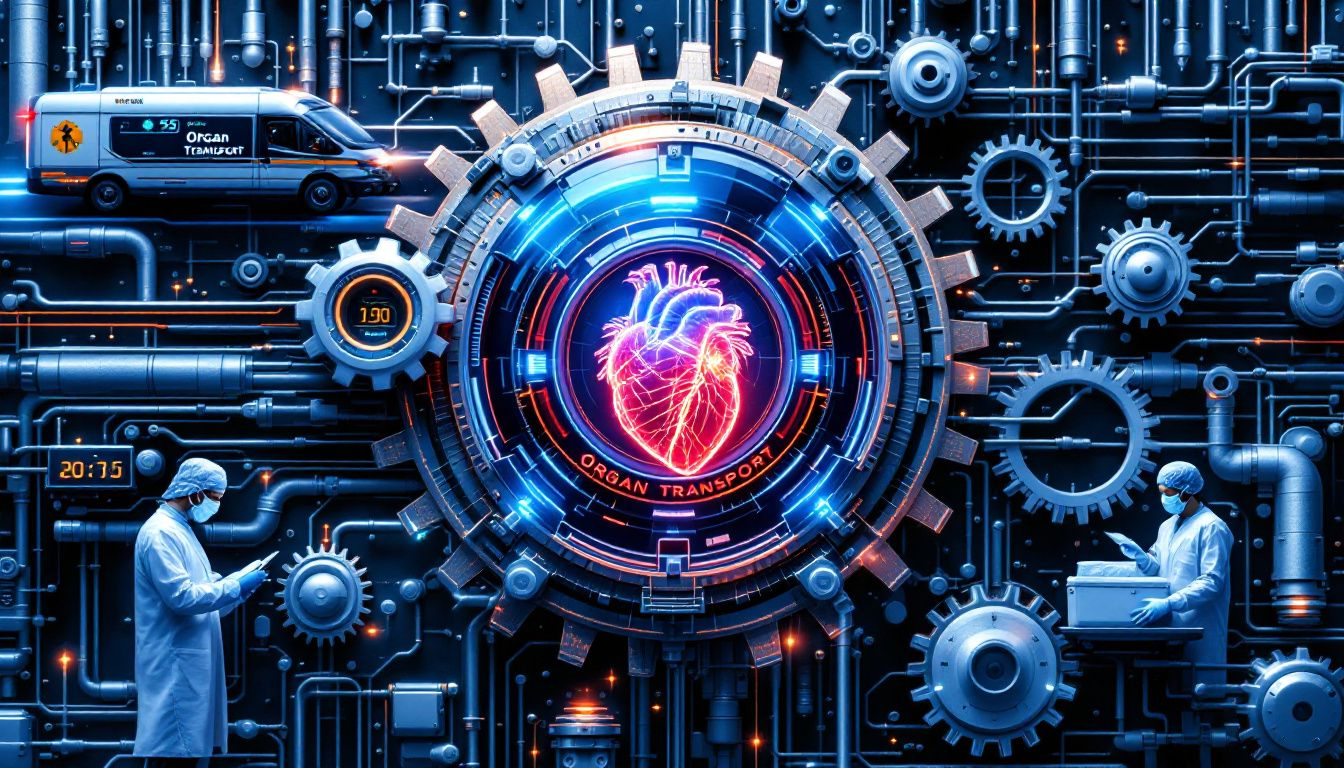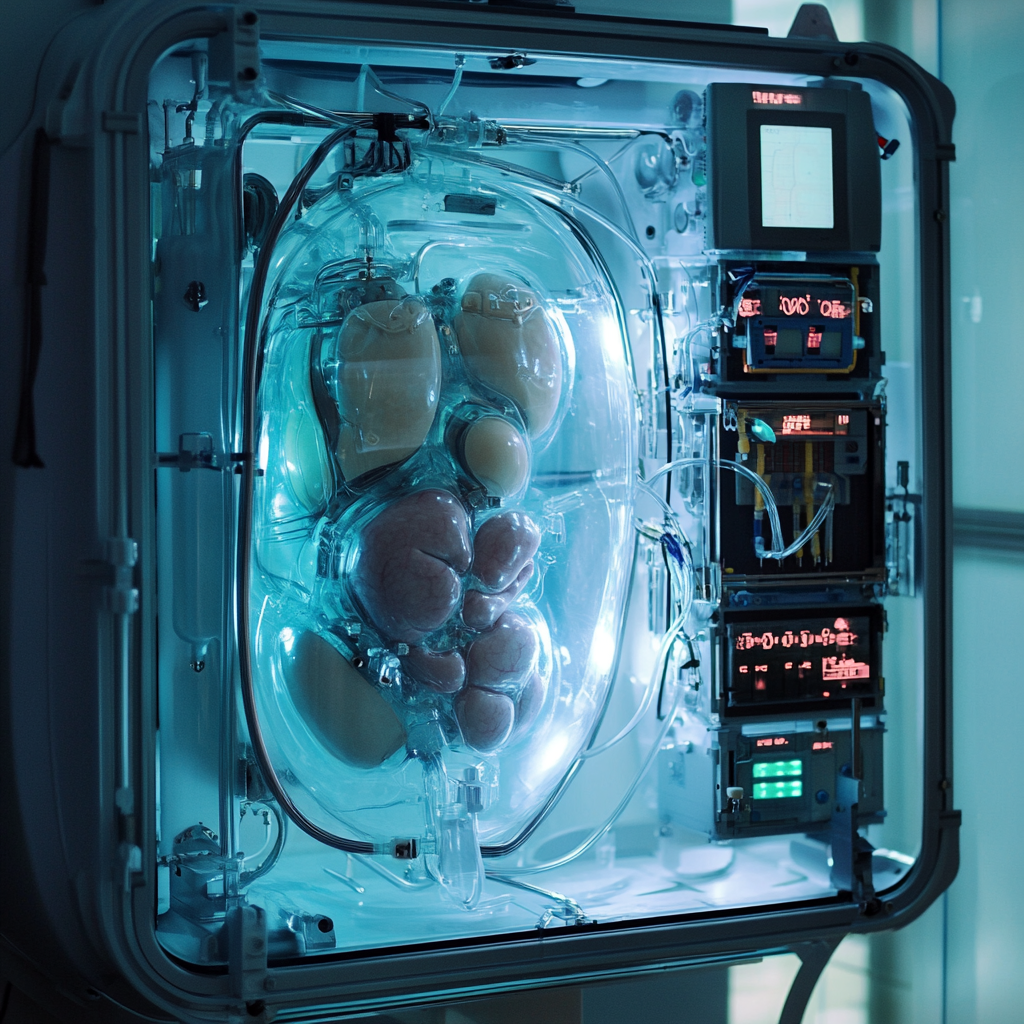The Best Practices for How Medical Teams Coordinate Organ Transport
How do medical teams coordinate organ transport efficiently? This process involves multiple steps and technologies, particularly in how medical teams coordinate organ transport. From transplant centers to national databases, this article explains every crucial role and action in ensuring that donor organs reach recipients safely and quickly.
Key Takeaways
Transplant centers are critical for the preservation, packaging, and coordination of organ transport, directly impacting transplant success.
Effective communication among healthcare professionals and educational initiatives foster teamwork, improving decision-making and patient outcomes in organ transplantation.
Innovative transport technologies, such as the Paragonix Sherpa Pak™, enhance organ viability during transit, while challenges remain in maintaining optimal conditions and time sensitivity.
The Role of Transplant Centers

Transplant centers are the beating heart of the organ transplantation network. These specialized facilities are responsible for the preservation and packaging of donor organs, ensuring they remain viable for transplantation at the transplant center. Timely and effective organ preservation directly impacts the success of the transplant.
Defined roles and responsibilities within the transplant team prevent confusion and enhance patient care. Each member of the transplant team, from surgeons to coordinators, must understand their specific duties to facilitate a seamless process. This structured approach ensures patient-centered health care, prioritizing the recipient’s well-being and recovery.
Moreover, transplant centers play a pivotal role in coordinating the transport of donor organs. They work closely with various entities to ensure that organs are transported efficiently and reach the recipient’s transplant hospital in optimal condition. Such coordination maximizes the chances of successful organ transplantation.
Organ Donation Process
The organ donation process begins with the identification of a potential organ donor. This often occurs when a person has died due to brain death or sudden cardiac arrest, and their organs are still viable. The process requires a delicate balance of medical criteria and ethical considerations, ensuring that the donor’s organs can be used to save lives.
Consent is a critical aspect of the organ donation process. Some individuals pre-register their consent to donate, while others leave the decision to their families. Effective communication by healthcare professionals can significantly improve authorization rates, as families are more likely to consent when they feel supported and informed. Training programs that improve communication skills for organ requesters foster empathy and sensitivity during organ donation discussions.
Families play a paramount role in the donation process and are less likely to agree to organ donation if they feel pressured or unprepared. Hence, healthcare professionals must approach these conversations with care, providing the necessary time and support for families to make informed decisions.
Ultimately, the organ donation process is a journey of compassion and coordination, where every step must be carefully managed to honor the donor’s legacy and save the lives of potential recipients, living donors, and tissue donation on the waiting list.
Coordination Among Health Care Professionals
Effective coordination among healthcare professionals is fundamental to successful organ transplantation. Once a potential recipient is identified, the transplant team must decide whether to accept the offered organ, coordinating logistics with the organ procurement organization. This decision-making process involves multiple stakeholders, including surgeons, nurses, and psychosocial clinicians, all working together to ensure the best outcome for the patient.
Educational initiatives that promote interprofessional collaboration enhance the competencies of team members involved in organ transplantation. Regular multidisciplinary meetings ensure effective communication and coordination among diverse specialists. Such meetings maintain high standards of care and address challenges during the transplant process.
The emotional toll of end-stage disease and critical decision-making can significantly impact the dynamics of the transplant team. Improving team communication and providing continuous support help manage stress and maintain professionalism. In this high-stakes environment, the collaborative efforts of a well-coordinated medical team can make all the difference in the success of the transplant.
Utilizing National Database Systems
National database systems play an integral role in the organ transplantation process. These databases, such as the OPTN, provide comprehensive data on transplant recipients and waitlist registrants, facilitating the effective matching of donors and recipients. Leveraging these systems ensures that transplant centers allocate donor organs fairly and efficiently.
A sophisticated computer system considers factors like blood type, organ size, and the recipient’s medical needs during the matching process. This ensures compatibility and minimizes the risk of organ rejection, thereby improving transplant outcomes. The United States Renal Data System (USRDS) is particularly valuable for studying kidney transplantation, offering extensive data on patients with end-stage renal disease.
Security and legal considerations are paramount when managing these databases. Maintaining the confidentiality and integrity of patient data ensures trust and regulatory compliance. As technology continues to evolve, national database systems will remain a cornerstone of the organ transplantation process, supporting the lifesaving work of transplant centers across the country.
Logistics of Transporting Donor Organs

The logistics of organ transport are complex and time-sensitive. Transplant centers coordinate with private flight services to ensure organs reach the recipient’s hospital quickly and safely. The use of certified couriers and tracking devices further enhances the security and reliability of organ transport.
Organs must be transplanted quickly after recovery to ensure viability, with some requiring surgery within hours of removal. This urgency necessitates meticulous planning and coordination to prevent delays. Transporting organs over long distances can introduce additional challenges related to time and costs, potentially affecting organ viability.
Recent changes in kidney allocation policies have implemented a broader sharing framework, which, while beneficial, can introduce logistical challenges. These challenges underscore the importance of efficient coordination and innovative solutions in the transport of donor organs. Ultimately, the goal is to ensure that every donated organ has the best chance of saving a life.
Did you know that you can get from Manhattan to JFK in under 5 minutes without driving?
Blade offers seamless helicopter transfers from our West 30th Street Lounge in Manhattan to JFK Airport in just 5 minutes from $195 per seat.
Skip the traffic and ditch the stress with Blade's year-round airport service.

The Role of Medical Teams in Operating Rooms
In the operating room, the transplant team performs the critical task of organ recovery and transplantation. A specialized team, separate from the medical staff that cared for the donor, conducts the surgical recovery of organs to ensure respect and integrity. This separation helps maintain the dignity of the donor while focusing on the precise technical requirements of the procedure.
Teamwork is crucial in this high-stakes environment. Perioperative nurses play a vital role, advocating for donors and ensuring high-quality nursing care during procurement. Operating theatre nurses assist during organ retrieval procedures, handling complex emotions with professionalism and dedication. Building trust and strong interpersonal relationships helps manage the stress and conflicts during transplant surgeries.
Balancing the emotional weight of organ procurement with the commitment to patient care is a formidable challenge for medical teams. Yet, their dedication and collaborative efforts are central to the success of organ transplantation, ensuring that each procedure is performed with the utmost care and respect.
Communication and Decision Making
Clear communication and decision-making are vital in organ transplantation. Regular multidisciplinary meetings help ensure that all transplant team members are updated and coordinated. Leadership reminders and open communication channels enhance team discussions and foster a supportive environment.
Addressing the psychological well-being of transplant professionals is crucial. Mental health seminars and process groups help mitigate stress and prevent burnout. Stigmatization of mental health treatment should be addressed, with regular reminders about the importance of self-care.
Ethical considerations are an integral part of the decision-making process. The Clinical Ethics Committee assists in navigating the complex ethical aspects of difficult healthcare decisions. Fostering a culture of open communication and ethical decision-making ensures that every step of organ transplantation is conducted with integrity and compassion.
Challenges in Organ Transport
Organ transport presents several challenges, particularly regarding time sensitivity and temperature control. The recommended storage duration for donor organs, such as hearts, is limited to 4 to 6 hours under cold conditions. This narrow window necessitates rapid and efficient transport to keep organs viable.
Current methods using ice for organ transport can sometimes lead to temperatures dropping below 0°C, increasing the risk of organ damage. Stable temperature maintenance during transport is crucial for preserving organ viability and function.
Addressing these challenges requires innovative solutions and meticulous planning to ensure the success of each organ transplant.
Innovations in Organ Transport Technology

Recent innovations in organ transport technology are revolutionizing the field. Advanced technologies like drone systems are being explored to enhance organ transport efficiency between hospitals. These innovations can significantly reduce transport times and improve the reliability of organ deliveries.
The Paragonix Sherpa Pak™ highlights the importance of specialized organ transport containers, maintaining organ temperatures between 4°C and 8°C without the need for power. This device minimizes cold injury during transport, ensuring the organs arrive in optimal condition. Specialized perfusion solutions and machine perfusion methods enhance the viability of marginal organs, increasing availability for transplantation.
Normothermic regional perfusion (NRP) allows transplant teams to perfuse organs at the donor site, significantly improving outcomes. These advancements aim to minimize the time organs spend outside the body, directly impacting their viability and the success rates of transplants.
Did you know that you can get from Manhattan to JFK in under 5 minutes without driving?
Blade offers seamless helicopter transfers from our West 30th Street Lounge in Manhattan to JFK Airport in just 5 minutes from $195 per seat.
Skip the traffic and ditch the stress with Blade's year-round airport service.

Case Study: Successful Organ Transport

A groundbreaking example of successful organ transport is the world’s first transplant of a genetically modified pig kidney into a living patient at Massachusetts General Hospital. This procedure utilized CRISPR-Cas9 technology to enhance the compatibility of the pig kidney with human recipients, marking a significant achievement in the field.
This case study highlights the essential role of teamwork and coordination in organ transport. This transplant’s success underscores the importance of meticulous planning, innovative technology, and collaborative efforts among healthcare professionals.
Bottom Line: The Best Practices for How Medical Teams Coordinate Organ Transport
Coordination and innovation are the cornerstones of successful organ transplantation. From the crucial role of transplant centers to the intricate logistics of transporting donor organs, every step demands precision and dedication. The collaboration among healthcare professionals, supported by national database systems and advanced transport technologies, ensures that donor organs reach recipients safely and efficiently.
As we look to the future, continued advancements in technology and a commitment to excellence in medical practice will further enhance the success rates of organ transplants, offering hope and new life to countless patients.
FAQs about The Best Practices for How Medical Teams Coordinate Organ Transport
What role do transplant centers play in organ transport?
Transplant centers play a crucial role in preserving and packaging donor organs while coordinating their transport to ensure they arrive at the recipient's hospital in optimal condition. This meticulous handling is essential for the success of the transplantation process.
How is the organ donation process initiated?
The organ donation process is initiated by identifying a potential donor who has experienced death without significant organ damage, followed by acquiring consent from the donor or their family. This crucial step ensures that the donation can proceed ethically and legally.
What challenges are involved in transporting donor organs?
Transporting donor organs poses significant challenges, primarily in maintaining stable temperatures to prevent damage and ensuring rapid delivery within the limited viable storage duration. These factors are critical to preserving organ quality for successful transplantation.
How do national database systems assist in organ transplantation?
National database systems play a crucial role in organ transplantation by facilitating effective matching and allocation of donor organs through comprehensive data on transplant recipients and waitlist registrants. This ensures a more equitable and efficient process in saving lives.
What innovations are improving organ transport technology?
Innovations such as the Paragonix Sherpa Pak™, drone systems, and normothermic regional perfusion are significantly improving the efficiency and reliability of organ transport. These advancements are critical in increasing the success rates of transplants.
Disclaimer:
Please be aware that the content on this page has been generated by using artificial intelligence language models and may contain errors, inconsistencies, or outdated information. It is provided as-is without any warranties or guarantees of accuracy. We strongly recommend using this content as a starting point for further research. We disclaim any liability for damages or losses resulting from the use or reliance on this content.